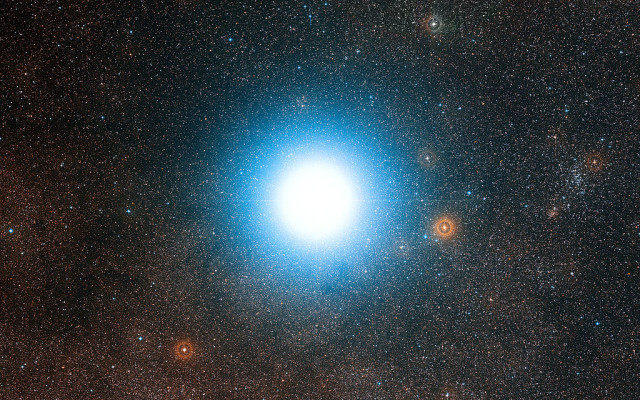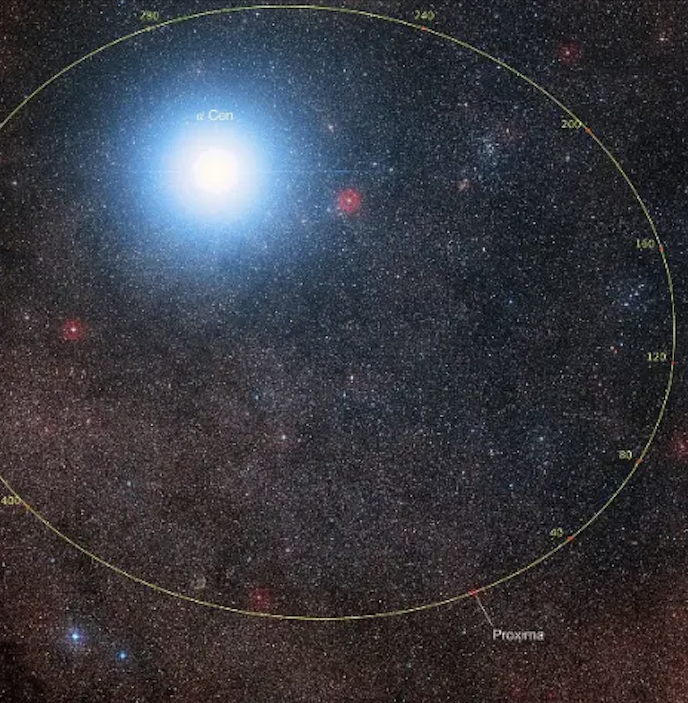I remember as a teenager, blinking though binoculars, excited that I could just make out Alpha Centauri as a double star. Then I borrowed a low-end refractor telescope and could more easily make out the binary nature of the pair.
It was the Jesuit, Father Jean Richaud (1633-1693), who first determined the binary using his 12-foot-long refractor in Pondicherry, India. While not in the southern hemisphere, Pondicherry is much closer to the equator than European cities. And Alpha Centauri and the accompanying Crux and Centaurus constellations are more visible viewed in the south.
Richaud’s refractor was the first telescope used in India, only 80 years after Galileo Galilei (1564-1642) had trained his improved version of the invention on Jupiter, discovering its four largest moons and bolstering Nicolaus Copernicus’s (1473-1543) heliocentric theory of the cosmos.
What must Richaud have thought upon his discovery? Here were two stars orbiting each other. Perhaps Earth was not the centre of the universe, and neither was the sun! With Catholic dogma clinging tenaciously to Ptolemy’s Earth-centred view of the heavens, it was unacceptable, even dangerous, for Father Richaud to draw any conclusions. as it stands, the Catholic Church did not accept heliocentrism until 1822.
If Richaud had conjectured any form of gravitational relationship between the two stars he observed, Father Louis Feuillée (1660-1732) provided further evidence. In 1709, Feuillée noticed that the positions of stars had shifted. Famous French astronomer Abbé Nicolas-Louis de Lacaillé (1713-1762) noticed an even more marked shift in 1752.
Breaking new ground
Alpha Centauri wasn’t the first confirmed double star system. In 1685, Richaud’s fellow Jesuit, Father Jean de Fontenay (1643-1710), observed Alpha Crucis in the nearby Southern Cross asterism. Fontenay made his observations from the Cape of Good Hope, South Africa. And Galileo and his champion, Antonio Castelli (1578-1643), discovered several binaries from 1617 onwards. Castelli was instrumental in defending Galileo’s findings and publishing his research papers.
With their spectral classes being G and K, Alpha Centauri A/B, also known as Rigel Kentaurus and Toliman, are sun-like stars. However, the fact that they orbit each other may make it difficult for life to gain a foothold on nearby planets. On the plus side, NASA’s Chandra X-ray Observatory has found levels of x-ray emissions similar to those of our sun.

If the Jesuits thought they had a monopoly on ground-breaking discoveries in the vicinity of Centauri/Crux, in 1915 Scottish astronomer Robert Innes detected a third component, Proxima Centauri. It turns out Proxima Centauri is the closest of all stars, hence its name: latin for proximity.
The Alpha-Centauri system was the second ‘star’ to have its distance measured. Scottish astronomer Thomas Henderson used the parallax method, observing from South Africa. Friedrich Bessel measured the first interstellar distance – to 61 Cygni – also using parallax, in 1838.
Measuring a star’s parallax involves using the extremes of the Earth’s orbit around the sun as a baseline. In other words, measuring the perceived (almost imperceptible) apparent angle of the star viewed six months apart. Assuming we already know the dimensions of the Earth’s orbit, we then use the trigonometric tangent function (opposite over adjacent side) to calculate the distance.
Origin of the parsec
If you’ve every wondered where the parsec distance unit comes from, it’s from parallax. The parsec is a precise, fixed distance, calculated by taking 1 arc second as the angle a hypothetical object would make against a fixed background of much more distant stars. A parallax of one arc second would be given by an object 3.3 light years away. Note: there are sixty arc seconds in an arc minute, 60 minutes in a degree, and 360 degrees in a circle. Only 180 degrees of sky are visible to an observer on the Earth. Resolving parallax to seconds of arc requires a powerful telescope.
At 4.3 light years, Alpha Centauri is therefore 1.3 parsecs away. But it’s not the closest star. That honour goes to Proxima Centauri, a red dwarf that orbits a common barycenter with the binary, Alpha Centauri AB. Needless to say, the gravitational dynamics of the entire system are quite complicated!

Proxima takes 550,000 years to complete a full orbit of the binary. This orbit is highly eccentric, with closest approach (periapsis) being about 4000AU* while the outermost limit of its orbit (apoapsis) takes it as far away as 13000AU.
The presence of at least one planet has already been confirmed in orbit: Proxima b. And it lies in the ‘habitable zone’. But life will have to overcome significant challenges if it is to flourish here.
Because of Proxima’s red dwarf status, it shines with only 0.16% of the Sun’s luminosity. Its habitable zone is therefore much closer to the star. In fact, Proxima b orbits its host star in only 11.2 days! The years go quickly! On Proxima b I’m over 1500 years old. Because it is so close, Proxima b is probably tidally locked, with one side permanently hot, the other cold.
In addition, observations made by the Chandra X-ray Observatory in 2017 indicate Proxima emits 500 times more x-ray radiation than our sun. It’s also a ‘flare star’. And when it flares, it can emit up to 50,000 times more radiation. This might be good for projecting people’s skeletons, but not good for longevity of life.
To boldly go…
Proxima Centauri gets its name because of its proximity: at 4.2 light years distance, it’s the closest star to the Sun. It will likely be the first system we visit, either directly or through probes, while Proxima b will likely be the first exoplanet we set foot on.
Centauri trivia:
Proxima Centauri
Age: 4.85 billion years
Class: M5 (red dwarf)
Mass: 0.123 solar masses
Size: 0.15 solar radii
Distance: 4.25 years
Absolute Magnitude: 15.6
Apparent Magnitude: 11.13
Alpha Centauri A/B (Rigel Kentaurus/Toliman)
Age: ~5 billion years
Class: A: G-type (yellow dwarf) B: K-type (orange dwarf)
Mass: A: 1.08 B: 0.9 solar masses
Size: A: 1.2 B: 0.9 solar radii
Distance: 4.37 light years
Absolute Magnitude: 4.38
Apparent Magnitude: A: 0.01 B: 1.33
In my science-fiction series, Tales from the Orion Arm, the Centauri system is an outpost with a very good football team, Real Centauri.

Our destiny is in the stars…